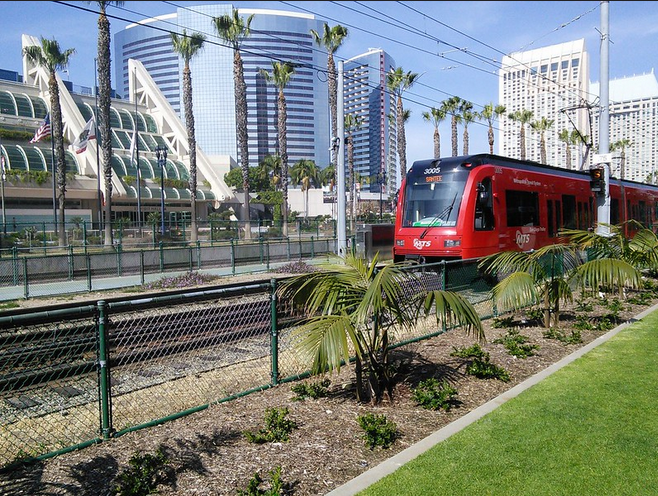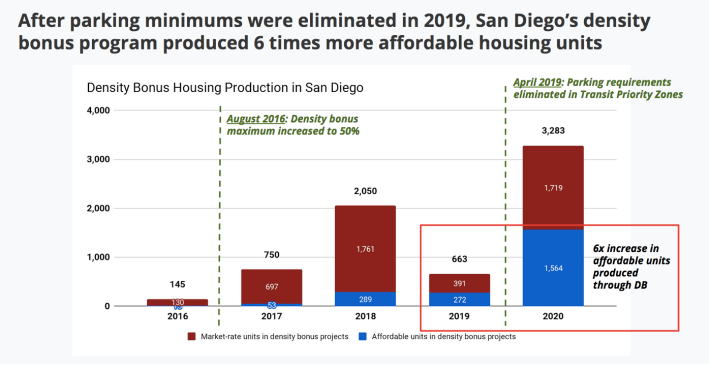Note: This article has been edited. An earlier version suggested that APA was an opponent of the bill, while its official position is “support if amended.”
Regular Streetsblog readers are aware of the many harms caused by on-site parking mandates - local laws that require new homes and businesses to provide a minimum amount of parking. These misguided policies raise the cost of housing production, discourage small-scale apartments, promote car dependence over transit use, and make neighborhoods less pedestrian-friendly. All this is disastrous for housing affordability, the climate, and public safety, and causes disproportionate harm to lower-income households and communities of color.
Fortunately, parking reform may be on the way in California. Assembly Bill 1401, authored by Assembly Transportation Chair Laura Friedman (D-Glendale), would eliminate parking requirements for buildings near public transit. Homebuilders and businesses would be free to decide how much, if any, on-site parking to provide.
Eliminating parking requirements is the simplest, most effective step that California can take to reduce carbon emissions, make housing more affordable, and increase production of homes for families across the income spectrum – all at no cost to the public. That’s why A.B. 1401 enjoys strong support from a statewide coalition of housing advocates, chambers of commerce, environmentalists, transit supporters, and urban policy experts, and was endorsed by the Los Angeles Times editorial board.
Although the benefits of parking reform are substantial, some housing activists have opposed A.B. 1401 on the grounds that eliminating parking requirements could harm affordable housing production. Even the California chapter of the American Planning Association has declined to support the bill as written. Their concern has to do with California’s “density bonus” program. The density bonus allows new multifamily developments to include extra units, build less on-site parking, and/or be exempt from other zoning requirements, in return for setting aside some units for lower-income households at an affordable rent. Developers opt to use density bonus incentives primarily when they can make more money building extra units than it would cost them to rent the affordable units at a loss.
A.B. 1401’s opponents fear that providing parking relief for all new housing would make the density bonus incentives less valuable and reduce market-rate developers’ motivation to include affordable housing in their projects. Similar concerns were raised in 2011 and 2013, when the California legislature also considered parking reform. Then and now, the objection was never to parking reform itself: skeptics just worried that reform might undermine the density bonus law.
How reasonable is this fear? There’s little empirical evidence that parking reform would undermine the density bonus. On the other hand, affordable housing is undeniably important, and parking reform supporters couldn't know with certainty what would happen to the density bonus if parking mandates for housing near transit were completely abolished.
They couldn’t know, that is, until San Diego completely abolished parking requirements for housing near transit, which it did in 2019. Data from San Diego's policy change provides evidence that parking reform did not harm that city's density bonus program. Rather, it preceded a huge increase in affordable housing production through the density bonus program, and is associated with higher housing production overall -- all this on top of the other environmental, economic, and social benefits that accompany ending parking mandates. This finding should put to rest any concerns that parking reform will undermine the density bonus law.
San Diego’s reforms took place in two steps. The first occurred in 2016, when the city strengthened its density bonus program, at the urging of transit advocates like Circulate San Diego and in response to improvements to the state density bonus program. The city’s reform increased the number of extra units that could be built in density bonus projects and reduced - but didn’t eliminate - parking requirements.
The 2016 reforms made the density bonus program much more attractive to developers. In 2018, San Diego permitted over 2,000 units in density bonus projects, up from just 145 units (and a paltry 15 affordable units) in 2016. This success was achieved during a period of falling overall housing production in the city.
But in 2018, parking mandates were still in effect, limiting both density bonus and standard housing production. Even after 2016, San Diego’s density bonus required 0.5 parking spaces per bedroom in mixed-income projects near transit, and 0.5 parking spaces per housing unit in 100% affordable projects near transit.
In 2019, San Diego enacted its second reform: it stopped requiring parking for any housing near transit, density bonus projects and non-density bonus projects alike. If the logic behind A.B. 1401 skepticism were correct, this reform to San Diego’s parking standards should have discouraged use of the density bonus program. If parking requirements are an important bargaining chip, abolishing them should have made the density bonus program less valuable to them. Fewer developers would have used it, and affordable housing production would have fallen.
Instead, the opposite occurred: in 2020, one year after comprehensive parking reform was implemented, there was a fivefold increase in the total number of homes permitted through San Diego's density bonus program. A record-high 3,283 homes were built using the density bonus in 2020 -- nearly half of all new housing permitted in the city that year. Total housing production citywide also rose, by 24 percent.
More use of the density bonus program also translated into more affordable units. The program produced over 1,500 affordable homes in 2020 - six times more than in 2019. Between 2016 and 2019, the program had never produced more than 300 affordable homes in one year.
Most of this growth in affordable units occurred in 100-percent-affordable buildings: 1,323 out of the 1,564 affordable units permitted in density bonus projects in 2020. This was a sixfold increase over 2019, when only 223 affordable units were permitted in 100-percent-affordable buildings. Additionally, affordable housing production in mixed-income density bonus projects -- the type that A.B. 1401’s skeptics worry about -- also rose fivefold, to 241 units, its highest number in five years.
What explains these results? Most likely it was a variety of factors: developers and regulators probably became more comfortable with the density bonus process, while rising rents and low interest rates made more projects feasible. But parking reform also likely played a role. In particular, parking reform helped make 100-percent-affordable projects more economically viable, and removed a major arrow in the NIMBY quiver: objecting to affordable housing on the grounds of insufficient parking. Of the many beneficiaries of parking reform, nonprofit affordable housing developers may be the biggest winners of all.
To summarize: after San Diego passed parking reform, its density bonus program produced much more housing than before. It produced more market-rate housing, more affordable housing in 100-percent-affordable buildings, and more affordable housing in mixed-income projects. While we can’t prove that eliminating parking requirements was the direct cause of new housing, there were no other significant changes to San Diego’s project approval process over the past two years, suggesting that parking reform was an important factor. The most important point, however, is that parking reform certainly did not discourage use of the density bonus program.
San Diego’s experience, which is essentially a pilot of A.B. 1401, demonstrates that comprehensive parking reform poses no threat to density bonus programs, and may even make them more successful at producing affordable housing. Given that this concern was the only point raised by opponents of parking reform, and given the manifold harms caused by parking requirements, the burden of proof now lies squarely on the defenders of parking requirements.
With A.B. 1401, California has the opportunity to learn from San Diego’s success and take parking reform statewide. Let’s not miss this chance to address our climate and housing emergencies, and make our neighborhoods more affordable to everyone.
Mott Smith is Chairman of the Council of Infill Builders, Adjunct Professor of Real Estate Development in the USC Price School of Public Policy and CEO/Co-Founder of Amped Kitchens. Anthony Dedousis is Director of Policy and Research at Abundant Housing LA. Michael Manville is Associate Professor of Urban Planning at the UCLA Luskin School of Public Affairs.









